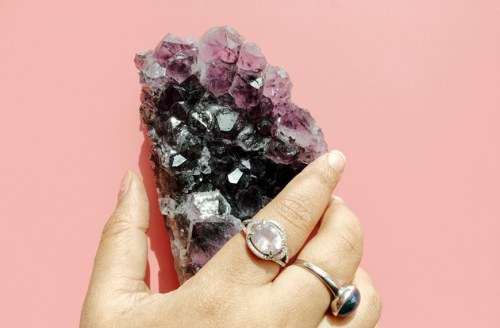Our editors independently select these products. Making a purchase through our links may earn Well+Good a commission
Man-made and natural crystals aren’t the same—but does this affect their healing powers?
According to energy-healing experts Mama Medicine and Energy Muse, there are some notable differences between man-made and naturally occurring crystals. Here's what you need to know.

When you’re a beginner in the healing world of crystals, your priority might be to, you know, actually start a basic collection (maybe even by foraging the stones yourself) before getting into the inside-baseball details of it all. But once you’ve created an energy-healing starter pack and are looking to expand your crystal collection and knowledge, you’ll notice that some crystals are made by humans and others occur naturally. Should you be concerned about the difference?
According to the Smithsonian, one of two types of crystals is a naturally occurring byproduct of an underground scientific process, and the other is a type that is entirely human made (and often in a lab). The distinction between natural and manmade stones is important for a few reasons since their age (natural crystals might be as old as 4 billion years!), how they were formed, and where they grew reportedly impacts their energy.
“When a crystal forms of natural circumstances, it holds the energy, memories and history of its surroundings: the earth.” —Heather Askinosie, Energy Muse co-founder
Heather Askinosie, co-founder of Energy Muse and an author of Crystal Muse, says that in the energy-healing tradition, it’s believed that “when a crystal forms of natural circumstances, it holds the energy, memories, and history of its surroundings: the earth. The earth holds history and evolution within it, and over the course of a crystal’s development, it holds that energy as well.” Alternatively, a lab-grown crystal, “holds the artificial energy of how it was created,” Askinosie explains.
And because natural stones reputedly carry the direct energy of the earth, it’s common that crystal and energy-healing aficionados prefer to work with this variety. Shaman and healer Deborah Hanekamp, AKA Mama Medicine, notes that “the main purpose of the use of crystals in healing has to do with the energy they carry,” after all.
“Anything that you own and truly love, your love will shift the vibration of it because love is the most powerful energy shifter.” — Energy healer Mama Medicine, on the value of man-made crystals
But this intel doesn’t render man-made crystals completely useless, let alone detrimental. Hanekamp says that this variety makes for great art or home decor, rather than a healing tool and adds that with “anything that you own and truly love, your love will shift the vibration of it, because love is the most powerful energy shifter.”
Basically, she says if you think something is powerful, it is—and, keep in mind that the placebo effect has proven to be scientifically useful. If you have an artificial crystal, Hanekamp advises, “The best way to clear the energy or charge the crystal would be to hold it in your hands and give it love.”
Can’t tell if you’re picking crystals from the earth or from a lab while perusing stones to add to your collection? Look at shape, texture, and color. Hanekamp says that the rougher a crystal is, the more likely it is to be natural. The man-made ones also tend to be less expensive, since there’s no rarity factor. If the shape of the crystal has been manipulated in any way (like into a heart, for example) or smoothed out, you should start to ask questions of the people working the establishment where you’re shopping about the stone’s origin.
Ultimately, buying a crystal is meant to be about your personal connection to the stone. So if you feel especially drawn to a glimmering piece that just so happens to be human-made—go with your gut, and bask in whatever healing powers you can glean from it.
If you’re obsessed with, crystals visit this Australian park ASAP, or stock up on some geode bath bombs.
Sign Up for Our Daily Newsletter
Get all the latest in wellness, trends, food, fitness, beauty, and more delivered right to your inbox.
Got it, you've been added to our email list.








